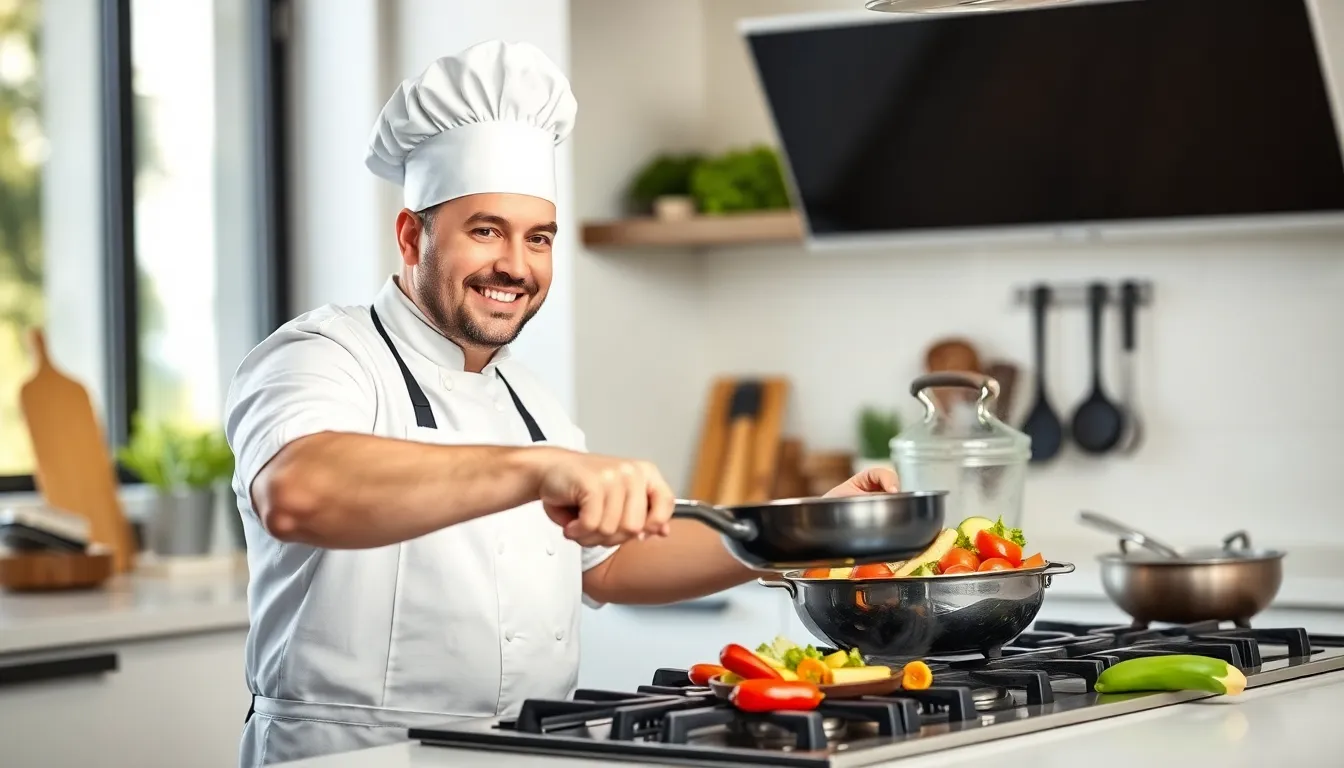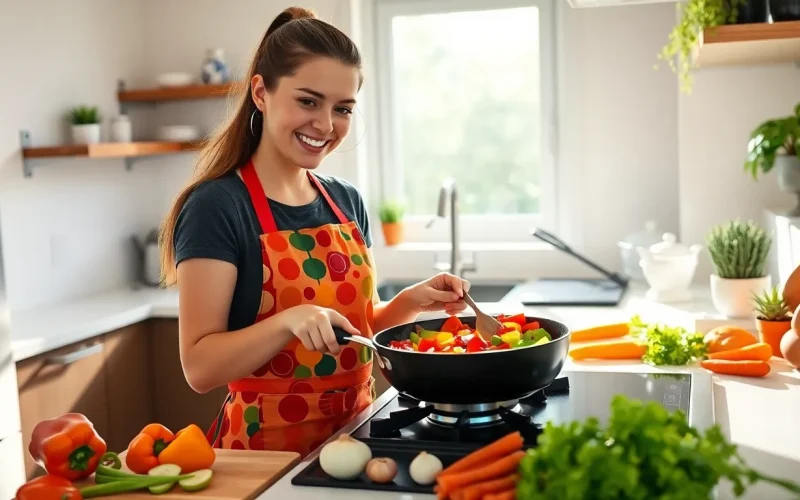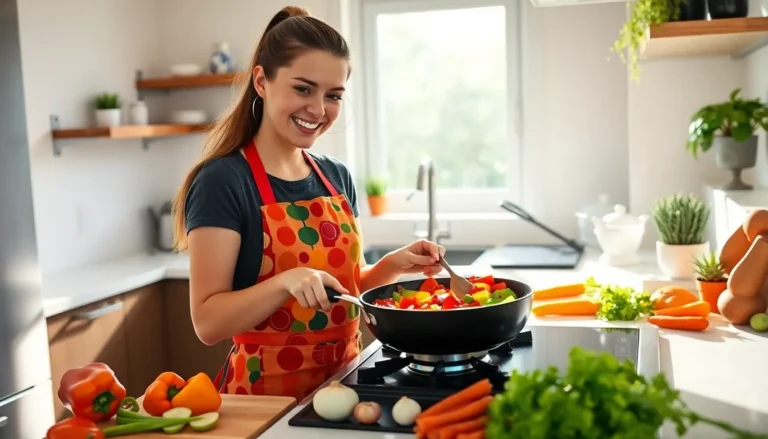Table of Contents
ToggleIn a world where takeout reigns supreme, mastering basic cooking techniques can feel like a daunting task. But fear not! With a sprinkle of patience and a dash of enthusiasm, anyone can transform from kitchen novice to culinary whiz. Imagine impressing friends with perfectly sautéed vegetables or a flawlessly seared steak.
Understanding Basic Cooking Techniques
Mastering basic cooking techniques forms the foundation of culinary skills. Sautéing involves cooking food quickly in a small amount of oil, allowing flavors to develop while maintaining texture. Poaching refers to gently simmering ingredients in a liquid, which yields tender results for proteins like chicken or fish.
Roasting, unlike other methods, cooks food evenly in an oven, bringing out natural sweetness in vegetables and enhancing the richness of meats. Baking, primarily used for pastries and breads, requires precise measurements and temperatures for optimal results.
Grilling imparts a distinct char, adding depth to meats and vegetables, making it a popular choice for summer cooking. Steaming involves cooking food in steam, preserving nutrients while keeping ingredients moist. Blanching briefly immerses food in boiling water, followed by an ice bath, ensuring bright colors and crisp textures.
Each technique has its unique application and purpose. For example, sautéing is ideal for dishes that require quick cooking like stir-fries. Poaching serves well for delicate proteins, while roasting works best for larger cuts of meat and hearty vegetables.
Cooking skills improve with practice. He or she can enhance their dishes by experimenting with various techniques, adapting styles based on desired outcomes. Simple dishes like sautéed greens or roasted root vegetables serve as excellent starting points. As confidence grows, tackling more complex recipes becomes not only manageable but enjoyable.
Essential Cooking Techniques

Mastering essential cooking techniques forms the backbone of culinary proficiency. Each method contributes unique flavors and textures, enhancing overall meal quality.
Boiling and Simmering
Boiling involves cooking food rapidly in bubbling water. Use this method for pasta, eggs, and vegetables. Simmering, on the other hand, uses a gentler heat, keeping the liquid just below boiling. It’s perfect for soups and stocks, allowing flavors to meld together. Both techniques require close attention to prevent overcooking or losing nutrients. Monitor food closely to maintain optimal texture and taste.
Sautéing and Stir-Frying
Sautéing combines small amounts of oil with high heat to quickly cook food. This technique works best with vegetables and proteins, creating a delicious caramelization. Stir-frying, borrowing from Asian culinary traditions, also focuses on high heat but involves continuous stirring. This method allows for even cooking and vibrant colors in dishes like fried rice and stir-fried vegetables. Both techniques encourage the use of fresh ingredients for enhanced flavor.
Baking and Roasting
Baking typically occurs in an oven and transforms ingredients through dry heat, perfect for bread and pastries. Roasting, ideal for meats and vegetables, also utilizes dry heat but at higher temperatures. This method caramelizes natural sugars, intensifying flavors. Both methods require proper temperature settings to achieve the best results. Preparing items evenly spaced on baking sheets ensures optimal air circulation and perfect cooking.
Knife Skills and Cutting Techniques
Mastering knife skills enhances overall cooking efficiency. Understanding various cutting techniques allows for improved presentation and texture.
Chopping and Mincing
Chopping involves cutting food into large, uniform pieces. Ingredients like onions and bell peppers benefit from this method, quickly creating the foundation for many dishes. Mincing requires smaller pieces, often used for garlic and herbs. Precision enhances flavor distribution in recipes. Use the tip of the knife for stability while rocking the blade. Consistent sizes improve even cooking, making it essential for recipes that require a balanced texture. Practicing these techniques increases speed and confidence in the kitchen.
Dicing and Julienne
Dicing creates cubes of equal size, suitable for stews and salads. Start with chopping food into slices before cutting them into uniform squares. An even dice guarantees consistent cooking and presentation. Julienne cuts produce thin, matchstick-like strips, perfect for stir-fries and salads. Begin with larger pieces of food, slicing them into strips, then cut across to achieve the desired size. This technique allows for quick cooking and adds visual interest to dishes. Mastering dicing and julienne techniques improves both appearance and taste in meals.
Cooking Methods for Different Foods
Various cooking methods suit different foods, enhancing flavor and texture while maintaining nutritional value. Understanding these methods enables chefs to make informed choices in the kitchen.
Vegetables
Sautéing works well for tender vegetables like bell peppers and zucchini, allowing them to cook quickly while retaining their crunch. Roasting enhances the natural sweetness of root vegetables, bringing out rich flavors through caramelization. Steaming preserves nutrients, making it ideal for broccoli and asparagus, as it cooks them gently without added fats. Blanching quickly cooks vegetables, like green beans, before plunging them into ice water to maintain vibrant colors.
Meats and Poultry
Grilling gives meats a smoky flavor while creating a crispy exterior, perfect for chicken breasts and burgers. Braising combines browning with slow cooking, which tenderizes tougher cuts like beef chuck and pork shoulder. Roasting whole poultry achieves a golden, crispy skin, while the meat remains juicy. Sous vide immerses meats in low-temperature water, ensuring precise cooking and moisture retention.
Grains and Legumes
Boiling works for preparing grains like rice and pasta, providing a simple, effective method for cooking. Quinoa benefits from rinsing before boiling, enhancing its nutty flavor. Cooking lentils involves simmering, which softens them while allowing flavors to develop. Baking can transform whole grains into delicious casseroles or bread, utilizing dry heat for texture and taste enhancement.
Mastering basic cooking techniques opens up a world of culinary possibilities. With practice and a willingness to experiment, anyone can elevate their cooking skills. Each method discussed serves a unique purpose and contributes to the overall quality of meals.
As confidence builds in the kitchen, individuals can explore new recipes and flavors. The journey from simple dishes to more complex creations not only enhances personal satisfaction but also impresses friends and family.
Embracing these foundational skills transforms cooking from a chore into an enjoyable and rewarding experience. With patience and enthusiasm, anyone can become a proficient home cook.





